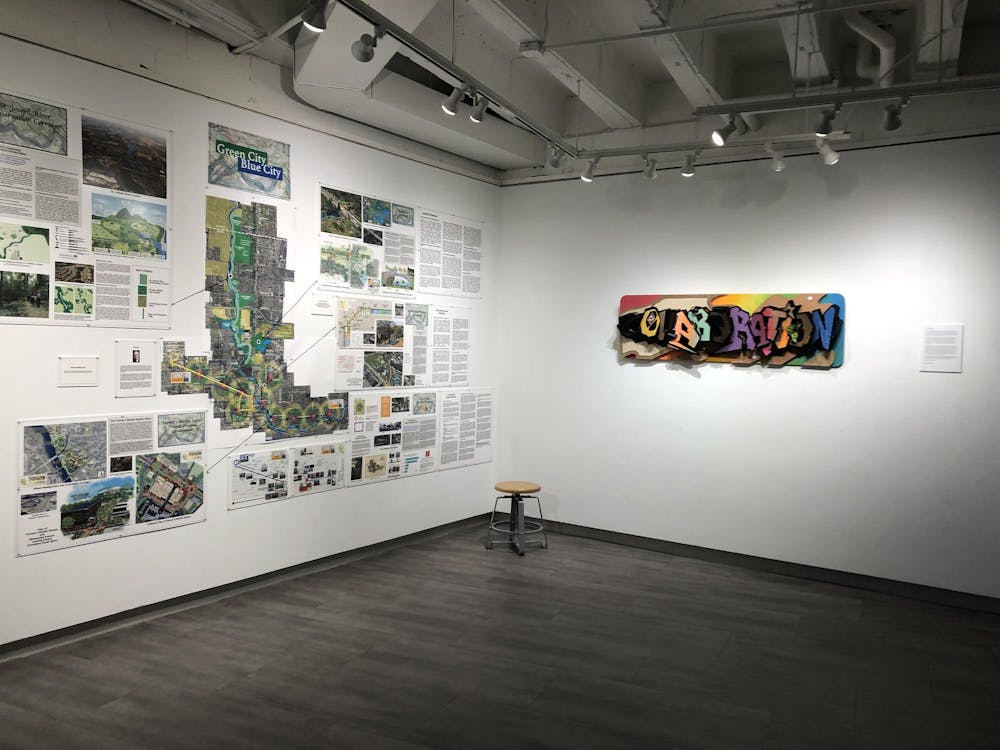Saint Mary’s is holding a faculty art exhibition this month, allowing professors in the art department to showcase their work.
Julie Tourtillotte, chair of the art department, said the faculty exhibition is held every four years so that all students have an opportunity to see the studio practice of the faculty during their time at the College.
This year’s exhibition will showcase work from Tourtillotte, Janice Cervelli, Brian Hutsebout, Doug Tyler, Sandi Ginter and Shreejan Shrestha, who is also the director of the Spark Lab. The works are as distinct as the artists themselves, with mediums ranging from landscape architecture to 3-D printed sculpture to hand-dyed fabric and more.
In her own work, Tourtillotte chose pieces that all use natural dyes.
“About two years ago, I started growing my own dye garden at home and began doing tests with dyes, so there’s a large piece that’s framed there on the wall that’s 25 different dye samples that I was collecting … and I wanted to be able to exhibit that in some way,” she said.
Tourtilotte’s large display of framed textiles is “almost encyclopedic, so it goes from indigo blue all the way down to walnut in the bottom right.”
“One thread that connects all of the pieces is my interest in expanding my knowledge of and direct experience with natural dyes, a fascinating subject with deep histories and cultural importance in many parts of the world,” Tourtillotte said in her artist’s statement.
She said her interest in sustainability drew her to working with and teaching about natural dyes. Tourtillotte looks to use materials in her art practice that are both safe for human health and the planet. Tourtillotte’s exhibition also includes handmade felt and knitted pieces crafted from hand-dyed yarn.
The exhibit also includes a plan for landscape architecture designed by Cervelli that seeks to improve life around the tri-campus and in the South Bend community. She is a member of a task force who will present her plan to the city council. This work includes improvements to the intersection of I-31, restructuring of wildlife trails and a bus system that attempts to alleviate traffic and improve South Bend transit.
Ginter’s work features an interactive space, where she invites attendees to respond to her ceramic work.
“On a micro scale, these works deal with the unbreakable, magical and sometimes frightening bond a mother has to her children. On a macro scale, they touch on the notion that we are all small parts of a whole. Like it or not, we will forever be a part of something larger than ourselves,” Ginter said in her artist’s statement.
Tyler, a professor of screen printing, photography and new media, presents works of photography created while on his sabbatical.
“In the digital photography that I teach, I encourage students to consider a variety of different types of recording tools that they can use,” Tyler said.
In keeping with this teaching, he used the panorama function in the camera app of an iPhone to create distorted images that bring up questions of “how these different devices and mechanisms redefine how we experience different times, different places and so on.”
In the center of the exhibition, Hutsebout’s installation piece explores “the importance of the body, the mind and memories contained within by recontextualizing my family’s history, both factual and perceived”.
“Through sculpture, installation and performance art, I pose a physicality to abstract concepts like memory, ancestry and trauma; as an effect, I consider my own identity and perceptions,” Hutsebout said in his artist’s statement.
The faculty exhibition this year provides students and members of the community the opportunity to interact with the studio practices of art department faculty and see the new ideas being explored at Saint Mary’s.
“Art was one of the first programs at Saint Mary’s College. I think this institution’s always had a reputation as a very creative institution where there was a real emphasis put on examining how we interact with our world and doing it in a creative fashion. Creativity, to a greater or lesser extent, is kind of what’s the primary focus of contemporary economies. Creativity is the basis of new ideas and those new ideas become new products, new products become new businesses, etc. So we like to say that students get an opportunity to rethink themselves as creative people,” Tyler said.










